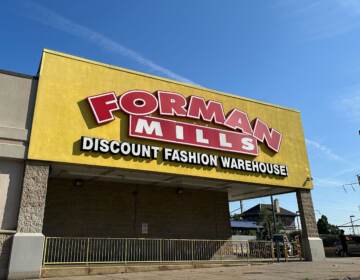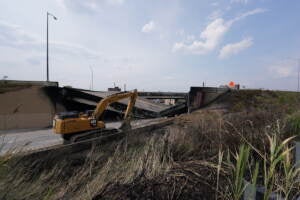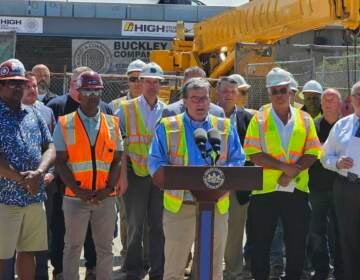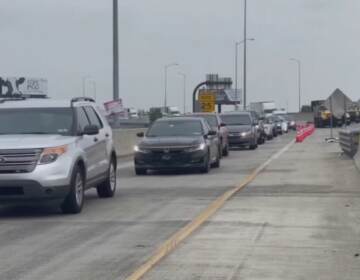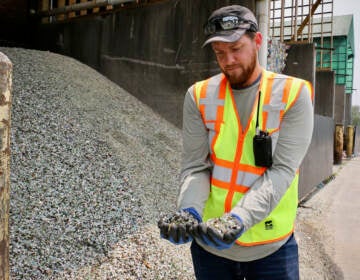Trucks face some traffic congestion after I-95 bridge collapse, PhilaPort ‘running smoothly’
Dozens of tractor trailers were diverted from I-95 for the second day in a row, leaving drivers scrambling to find alternative routes in Northeast Philadelphia.
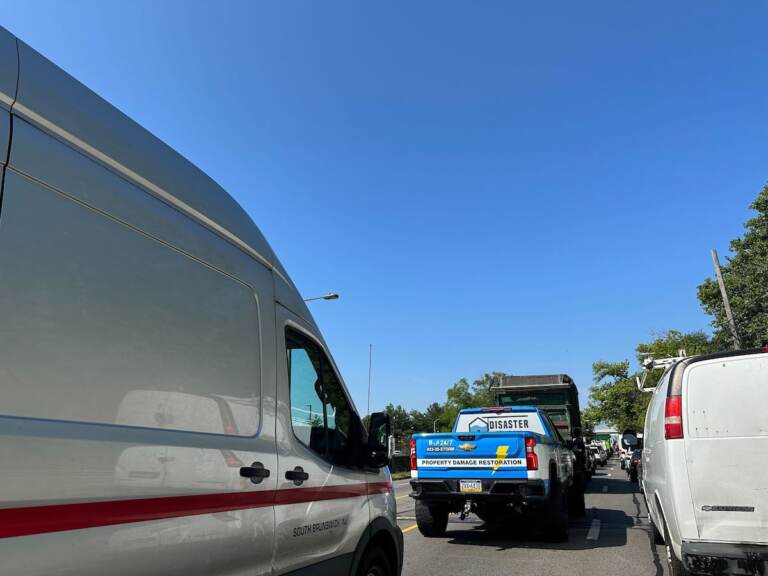
A long line of cars and trucks were backed up along State Road on Tuesday morning parallel to I-95 which was closed after a bridge collapse over the weekend. (Kristen Mosbrucker-Garza/WHYY)
On a typical day, about 14,000 trucks drive along I-95, bypassing city streets.
But two days after a truck caught fire, causing the bridge collapse near the Aramingo Avenue exit in Northeast Philadelphia, dozens of tractor trailers found themselves navigating neighborhood corridors on detour routes instead. Trucks were mostly able to navigate along avenues and the U.S. Route 1 but sometimes found themselves on much smaller streets.
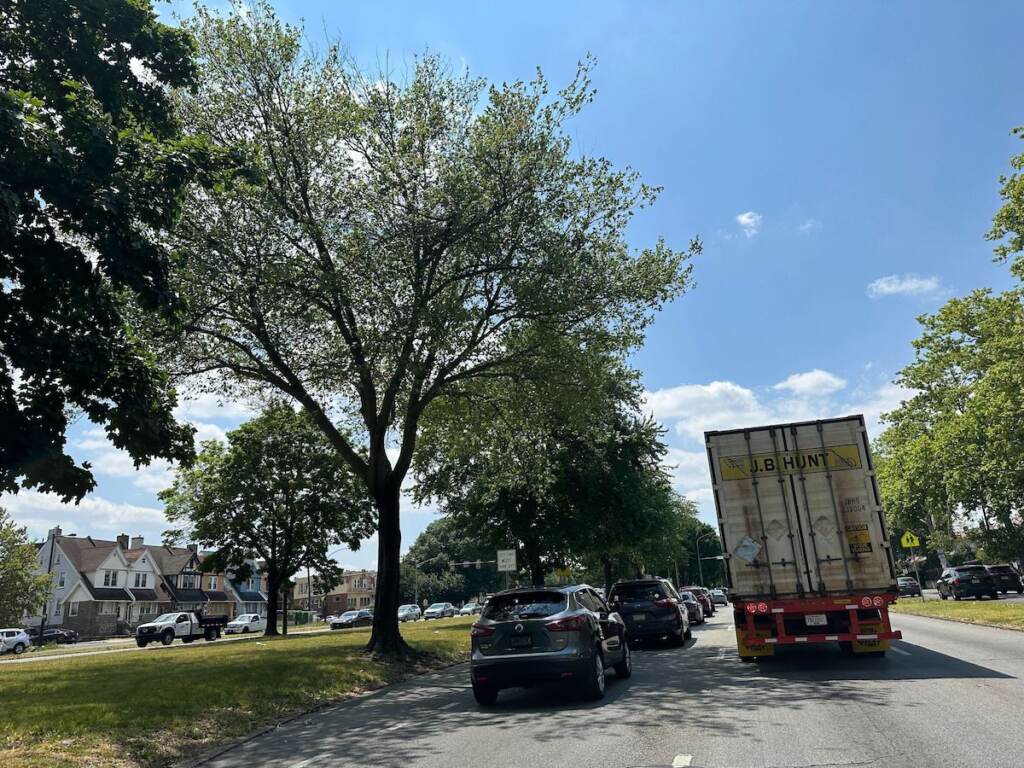
Inside a Torresdale Avenue parking lot, John, a tractor trailer truck driver, was fixing his tire. He said he wasn’t itching to get back on the road anytime soon, and wanted to avoid the traffic snares.
“Right now, from here to New Jersey [it’s] easy. But if you go towards like … downtown, it’s terrible,” he said. “And you have to go around. You can’t go straight. You know it’s very bad traffic now.”
Pennsylvania Truck Association CEO Rebecca Oyler said this stretch is significant as a commercial corridor. The U.S. Route 1 truck detour has 60 traffic lights. That’s almost an extra hour of driving between Northeast Philly and Center City.
“This section of the highway is really a critical point through which goods are transported to and from New England and the East Coast by truck,” Oyler said.
The issue with long delays is that truck drivers are only allowed to drive 14-hour shifts and need to take regular breaks. The Harrisburg-based organization represents 1,200 trucking businesses and service companies.
“So if they’re sitting in traffic for a long time that still adds to their hours for the day,” Oyler said. “That will affect their ability to get the freight where it needs to go. It’s not like they can say, ‘Oh, I’ll just drive longer.’ They’re not allowed to do that.”
There are dozens of industrial businesses along I-95 as a freight corridor, from the Port of Philadelphia to manufacturers and even an ambulance hub.
“Those are the types of industries that are really going to feel the brunt of this disruption, probably due to the kind of additional surface street delays and diversions for shipments that are trying to get in and out of this area,” said Kristen Scudder, manager of the Delaware Valley Regional Planning Commission Freight Planning Program. “General increased congestion on the parallel and alternative routes, especially during peak rush hour periods, and the diversion of trips will slow their supply chain movements down.”
Each day, roughly 1,000 trucks travel in and out of the Port of Philadelphia as most cargos are taken from ships to trucks.
While the port sits just east of where the bridge collapsed, officials said Tuesday that operations are running smoothly so far. Port customers import refrigerated foods like fruits and wood pulp products, which are mostly loaded onto trucks despite a nearby railyard.
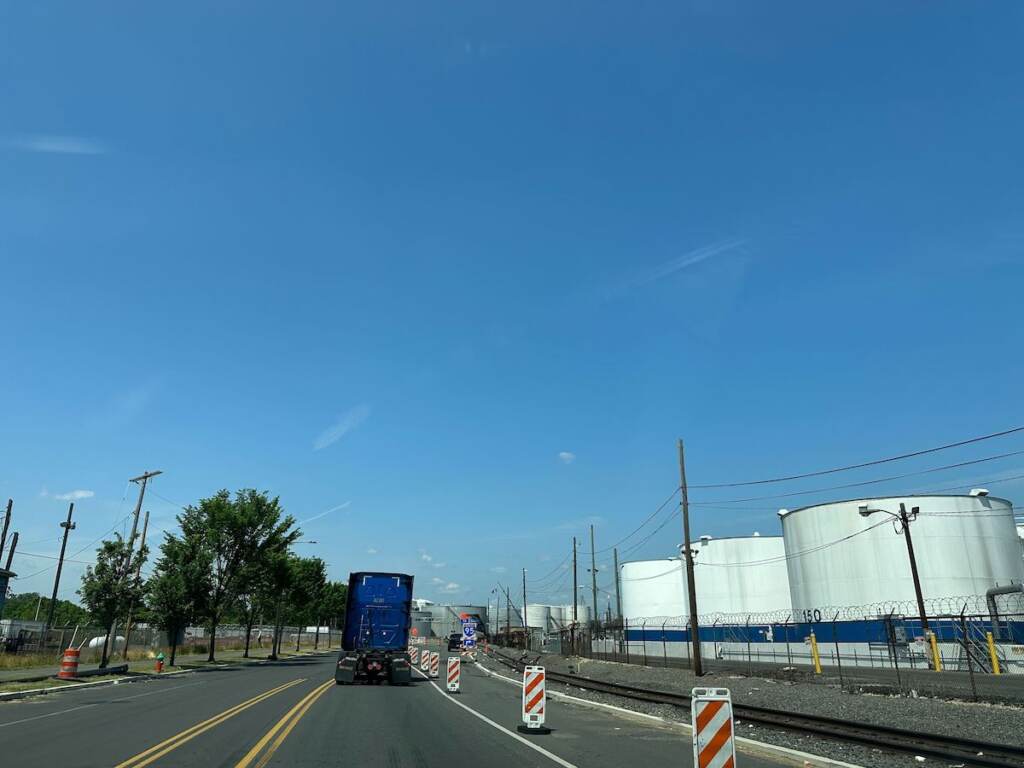
“Some cargos move by rail but the majority are still moved by trucks,” said Ryan Mulvey, PhilaPort public affairs director. “We have not seen the delays in the truck movements. I think that’s a testament to the way the detours are set up. We also haven’t really heard of any delays or disruptions to the movement of cargo. We’re still monitoring it.”
On a smaller scale, Keystone Quality Transport, a local non-emergency ambulance company that takes patients to doctor’s appointments, hospitals, and rehabilitation centers, operates a hub in Port Richmond.
“So far we’ve been able to keep up the regular schedule,” said Danny Platt, CEO of Keystone Quality Transport, about its fleet of 15 trucks.
Once employees are on the road in the ambulances, they are able to arrive on time, but workers trying to clock in before their shift are often delayed.
“Trying to get to work is probably the biggest impact,” Platt said. “People trying to navigate traffic, getting to the office.”

Get daily updates from WHYY News!
WHYY is your source for fact-based, in-depth journalism and information. As a nonprofit organization, we rely on financial support from readers like you. Please give today.




